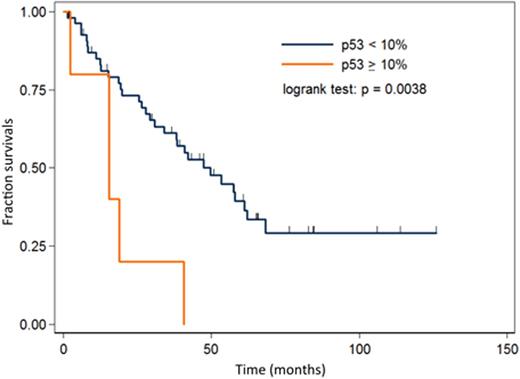Abstract
Background
The p53 protein is an onco-suppressor protein encoded by the TP53 gene, which is mutated in 5-10% of cases of de novo myelodysplastic syndromes (MDS). In 75% of cases TP53 mutations lead to store the p53 protein within the nucleus of the neoplastic cells. TP53 mutations were shown to have an unfavorable prognostic impact in patients with MDS. The immunohistochemical (IHC) expression of p53 in bone marrow (BM) biopsy has in itself negative impact on prognosis in low risk MDS, especially in MDS with isolated del(5q) category. However, the p53 cut-off value related to prognosis has not been established with accuracy, ranging between 1 and 5% in different reports. Moreover, no data are available on the possible prognostic impact of p53 BM expression and cut-off levels in patients with higher risk MDS.
Aim
To evaluate the prognostic value of IHC expression of p53in BM biopsies from patients with intermediate, high and very high R-IPSS risk MDS
Methods
BM biopsies performed at diagnosis in patients with intermediate, high and very high R-IPSS risk MDS with a follow up of at least three years were revised and screened for IHC p53 expression. Percentage of p53 expression was evaluated by two independent pathologists (L.B.; M.T.), and related to patient survival. Only cells with strong p53 staining were counted as positive. The statistical evaluations were carried out with the logistic analysis and the influence of p53 expression on survival was analyzed by Cox regression. A ROC analysis was carried out using theYouden method to analyze the optimal cut-off value influencing the survival. The verification was performed with the positive and negative predictive values (respectively PPV and NPV), the sensibility and the specificity with their respective 95% confidence intervals (95%CI). Survivorships were estimated with the Kaplan-Meier product limit method, followed by the logrank test, and by the Cox proportional-hazard regression. The association among categorical variables was evaluated by Fisher exact test.
Results
A total of 60 BM biopsies performed at MDS diagnosis were screened for p53 expression. Themedian age of these 60 patients was 67 years (range 19 - 82). Diagnoses, according to WHO, were RCMD in 26/60 (43.3%) cases; RAEB1 in 21/60 (35%) cases; RAEB2 in 13/60 (21.7%) cases. The IPSS-R was intermediate in 43 (71.7%) cases; high in 9 (15%) cases and very high in 8 (13.3%) cases. Cytogenetic risk according to the IPSS-R stratification was: very low in 1(1.6%) case; low in 30 (50%) cases; intermediate in 10 (16.7%) cases; high in 12 (20%) cases; very high in 7 (11.7%) cases. Median overall survival was 41 months. The p53 expression was: < 1% in 39 cases (65.0%), 1% in 5 cases (8.3%), 2% in 6 cases (10.0%), 3% in 2 cases (3.3%), 5% in 3 cases (5.0%),at least 10% in 5 cases (8.3%). Upon analysis, a significant association between percentage of p53 expression and patient survival was found (p=0.013; Hazard Ratio 1.067; 95%CI: 1.014 - 1.124). A cut-off value of 10% p53 expression was associated with outcome (specificity 100%; sensibility 13.5%;PPV 100%; NPV 41.8%). Specifically, as shown in figure 1, a significantly better overall survival was observed in the 55 (91.7%) patients whose BM p53 expression was < 10% compared to the 5 (8.3 %) patients with a BM p53 expression at least 10% (p=0.0038). No association was found between either BM blast countor BM grade of fibrosis and p53 expression.A significant association between the cytogenetic risk according to R-IPSS stratification and the expression of p53was instead found: any single unitary arbitrary increase in the cytogenetic risk score rises by 1600% the odds of a BM p53 expression at least 10% (p=0.015).
Conclusion
In our study population we confirm the unfavorable prognostic significance of BM p53 expression in higher risk MDS patients. Contrary to the reported cut-off values of p53 expression in low risk MDS, in our cohort of higher risk MDS the levels related to prognosis were greater (10% compared with 1 to 5% according to different reports). A tentative explanation for this difference may be that factors other than p53 expression strongly impact on survival in patients with higher risk MDS. Thus the negative prognostic value of p53 only emerges at higher levels of expression. The association between p53 expression and the IPSS-R cytogenetic risk score, if confirmed on a larger cohort, should be evaluated in specific biologic investigations.
No relevant conflicts of interest to declare.
Author notes
Asterisk with author names denotes non-ASH members.


This feature is available to Subscribers Only
Sign In or Create an Account Close Modal